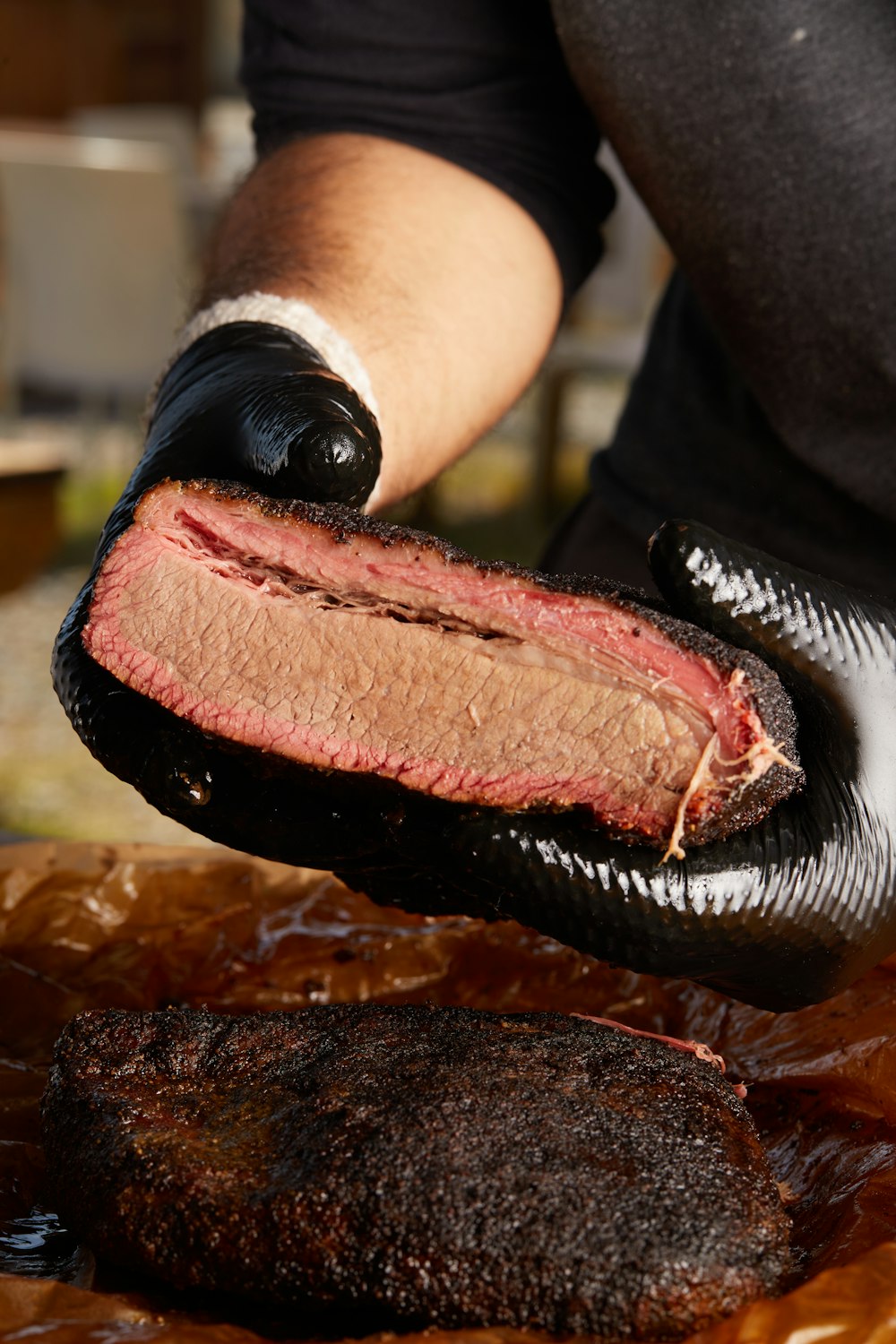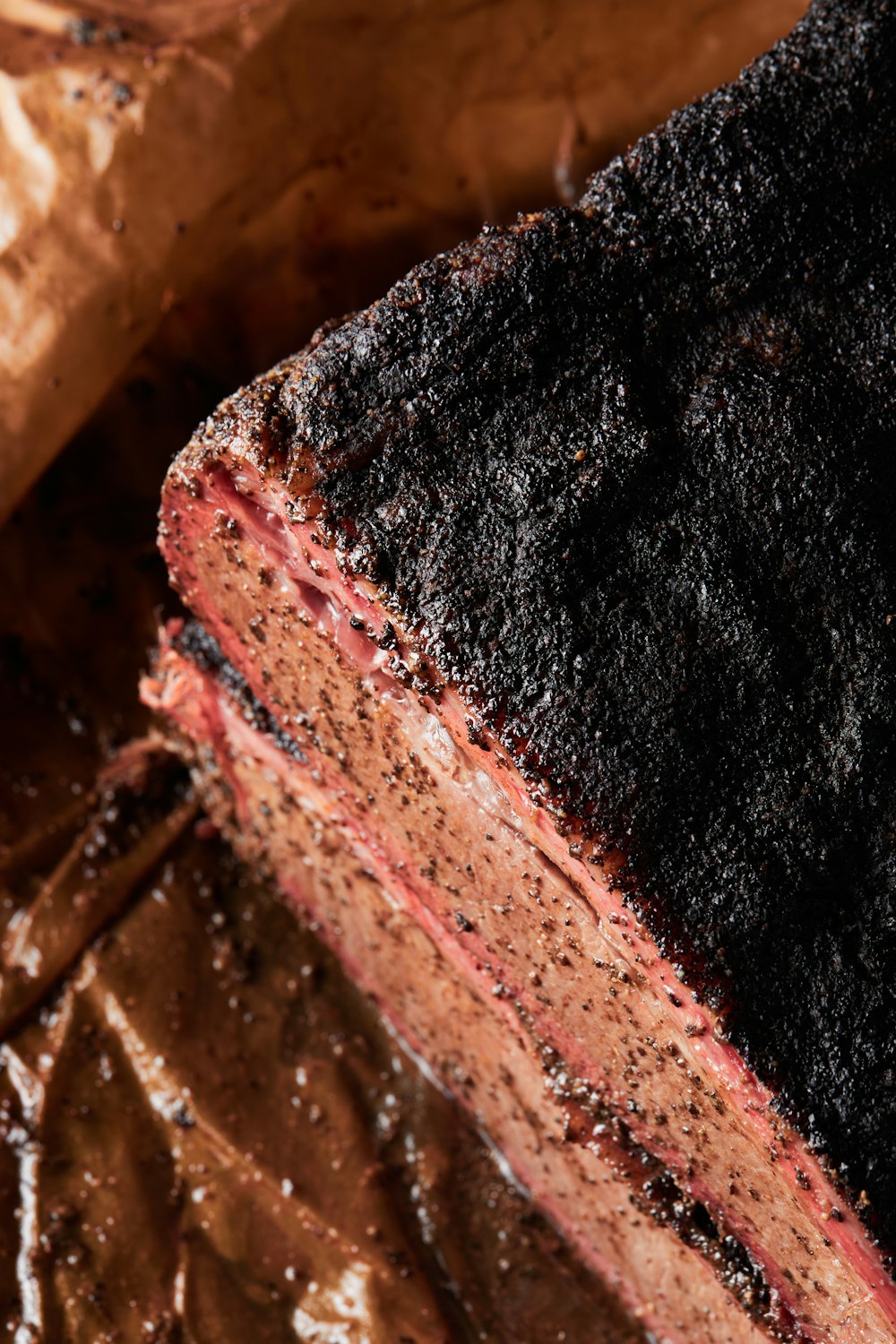Bark is that appealing, dark, and crispy rub of seasonings on briskets and smoked meat that serve to add flavor and added texture. As its name suggests, bark is precisely that: a hard outer layer.
But rather than the tough, woody stuff that covers trees, this bark is the kind that covers meat and is highly edible and delicious.
You achieve the perfect bark by following a precise process of preparation and cooking. When the right combination of salt and seasoning, water vapor, smoke, and heat is used, you can look forward to a bark formation on your brisket that you won’t soon forget.
In fact, when you learn how to get good bark, you’ll want to return to it again and again. But before we get too ahead of ourselves, we need to go over the essentials of bark preparation. In this guide, we’re going to do just that, teaching you essential tips so you can enjoy great bark on your meat’s surface.
What Creates Bark on Brisket?
First things first. As you research how to get great bark on brisket, you’re sure to come across the term “The Maillard Reaction.” What does this mean and how does it apply to bark?
Maillard Reaction
This reaction refers to a chemical reaction that occurs between amino acids and reducing sugars. This action results in browned food getting its distinctive flavor.
Not reserved for just briskets, the Maillard Reaction occurs on foods like steak, bread, biscuits, toasted marshmallows, fried dumplings, and cookies, for example.
Essentially, brisket bark comes from the evaporation of the moisture from the meat when it’s exposed to low temperatures.
As the moisture from the meat evaporates and the fats of the meat liquefy and begin to bubble, smaller particles like salt begin to penetrate into the meat. This, in turn, assists in producing your smoke ring.
The bigger molecules like your brisket seasonings stay on the surface. In doing so, they begin to brown and mix in with the fats of the meat. This ultimately creates the dark, tasty bark that you’re striving to achieve.
It’s important to mention that creating bark is very different from caramelization. While they might look similar, caramelization is the result of sugars being cooked at temperatures above 300°F. Bark is achieved when you grill your brisket or other meats at temperatures well below 300°F.
In the process of caramelization, the sugars on the food burn. In doing so, they actually change their chemical composition, causing them to taste different than they do in their normal state.
Caramelization requires great care, as too high a temperature or time cooking can lead to negative effects on your food. It won’t be the same and is likely to ruin any flavoring that remains intact. The same is true when creating bark.
The last thing you want is to serve your guests brisket that looks like it has great bark, only to bite into it and find that the meat isn’t done. One of the key aspects of bark is taking your time to ensure optimal results.
Pellicle
This is another term not too many people are familiar with when first entering the world of bark building. The pellicle is the outer surface area on your meat. Think of it as the top skin. The scientific definition of “pellicle” is skin or a coating of proteins on meat, fish, and chicken.
When you apply a rub to your meat, you’re applying it to the pellicle. Any soluble ingredients get absorbed into the pellicle, thereby trapping in and harnessing the rich flavoring that comes from your various dry rub powders.
How Do You Get the Best Bark on a Brisket?
And now for the “meat” of this guide. Whether you’re trying for a thick or thin bark formation on your favorite brisket or pork butt recipe, we’ll show you how to get good bark every time. Achieving the crust of your dreams is going to take some practice, but stick with it.
The effort and patience that go into perfecting your meat’s surface are well worth it. In the end, you’ll have a superior bark that locks in flavor.
There are many theories as to how to achieve the best bark. Some say it’s a combination of applying the right amount of moisture, salt, and seasoning at specific temperatures and for a specific amount of time.
Still, others claim that you can simply throw rub on your barbecue, apply moisture periodically, and the rest works itself out.
And then there are those who throw meat in a pan and apply all manner of salty and acidic rubs to see what happens, all the while hoping for success. Some people can achieve good bark this way, but it’s really a matter of trial and error at this point.
If you’re serious about getting a superior bark formation on your meat, you need to follow the methods that are proven to yield the best results. While there’s certainly nothing wrong with experimenting in the kitchen, we’re here to share the best ways to get great bark.
Good Rub Is Essential
For our first method, you’ll need to start out already having a good amount of seasonings on your meat. This foundation is essential in achieving good bark. As such, it’s crucial that you maintain this spice rub throughout the cooking process.
Any that falls off needs to be restored to ensure the best results. Keep doing this as needed so you can end up with a spice crust you’ll be proud of. You may need to play around with different seasonings until you find the combination you like the best.
There are countless kinds you can try, each with its own amounts of salts, seasonings, sugars, and other ingredients.
The slightest variation in rub ingredients can make all the difference in the way your bark tastes. It’s therefore a good idea to try out several so you can be sure to find the one that best suits your tastes.
Spritz Your Meat
Spritzing your meat will allow you to build BBQ bark layers. This is something that’s often debated among bark builders, but there are a significant number of people who agree that it aids in making some great-tasting bark.
Simply fill a spritzer bottle with ingredients like:
- Worcestershire sauce
- Apple cider vinegar
- Balsamic vinegar
- Mustard
But don’t stop there. These are just suggestions; there are many other ingredients you can try to reach the perfect flavoring in your bark.
Ensure there are no sizable chunks or lumps in whatever you use so it doesn’t stop up your container, and attempt to stay away from anything that is really high in sugars that may burn away at higher temperatures.
Spritzing works much better compared to a lot of different strategies for adding moisture during a cook. To begin with, it’s considerably more measured and simpler to apply just to portions of the meat that are required.
It’s additionally a lot easier to prevent the dry rub from washing off after you’ve applied it to your meat. And lastly, it gives the ideal measure of moisture so that smoke particles stick to your meat better, locking in flavor and aroma.
What’s more, spritzing down your meat serves to slow down the cooking process significantly, thereby giving you more time to perfect good bark.
Just keep in mind that spraying the bark will work to soften it. However, the flavor from your spritz is going to dry up over time, leaving behind added taste every time you spritz down your meat. And if you want to make your bark even thicker than it already is, you can always add more rub after you spritz.
Cook Slow & Low
Cooking your meat slowly and at low temperatures serves to enhance the bark preparation process. Whether pork shoulder, brisket, or ribs, your meat and bark are sure to be better when you avoid high heat.
In fact, higher temperatures make it nearly impossible to build a decent rub of bark on your meat. As such, it’s vital that you keep your heat reduced to temperatures no greater than 225°F. In doing so, you can look forward to the best results – both in your meat and bark.
Cooking your meat slowly can be done with the right smoker grill combo to help you reach the right internal temperature.
Go Easy on the BBQ Rub
There’s no question; too much rub will result in your food tasting overpowered. Additionally, too much spray will wash away anything that you’ve applied.
And while there isn’t an exact science to this, going easy on your BBQ rub makes it a lot easier to fine-tune your ingredients as you proceed through the bark-building process.
Remember, you can’t remove your BBQ rub once you’ve applied it. But you can always add more. Keep this in mind as you work toward crafting the ultimate bark formation.
Food for Thought
Now that you know some of the science that goes into building the perfect spice rub, let’s shift our focus to some helpful tips. By following these and applying them to your recipes and preparation, you can expect great things from your bark.
Remove Excess Fat
Any time you remove excess fat from your meat, you are allowing for a more usable surface area. This results in a better pellicle and helps to improve bark formation. What’s more, the cutting of fat ensures that you get the best taste in the end.
Avoid Foil
Many recipes call for using foil to expedite cooking times. While this might seem like a reasonable idea, you should never use foil when crafting bark. Why? The foil actually causes the bark to become soggy and gritty, leaving you with a nasty mess to clean up.
Not only that, but your bark won’t stay on your meat. Remember, you want to take your time when building bark. Attempting to speed up the process is likely to ruin your hard work.
Create More Surface Area
As we explained in our tip to remove excess fat, more surface area on your meat allows for more room for your spice crust. Therefore, consider cutting your large portions of meat into sections that make it easier for your bark to rest.
A large, rounded cut will only result in your spices falling off. You can also cut gashes in your meat to help keep your spices in place.
Don’t Place Your Meat in a Pan
It’s certainly OK to have a pan underneath your grill or smoker to catch drippings. But if your meat is directly in a pan, it will reduce convention and smoking. Meat needs to be allowed to absorb as much smoke as possible. Placing it in a pan will prevent this from happening.
Use Fat-Soluble Ingredients
Rosemary, thyme, savory, sage, and chili flakes are all fat-soluble ingredients. Whenever you heat these spices in fat, it allows you to get more flavor out of them.
Try steeping these spices in warm oil for about 20 minutes before you cook with them. In doing so, the flavors will bloom and enhance your meat significantly.
Ideal for Bark
When crafting bark, it’s important to have a spice rub that contains salt and sugar. If you’re aiming to get a thicker spice crust, try using spices like garlic powder, onion powder, and pepper.
Salt and sugar help to create the perfect foundation to build upon. Then experiment with garlic powder or any other seasonings to achieve the perfect balance of flavor.
Watch Your Temperature
Temperature is a critical component to creating great bark. If it’s too low, you won’t be able to build your bark. If it’s too high, caramelization will occur instead, causing your meat to char and taste poorly.
The ideal temperature range is between 200°F and 250°F. Anything past 250°F will exceed the ideal temperature and lead to ruining your bark.
Plenty of Smoke
Smoking meat is another essential component to crafting the perfect bark rub on your meat. Smoked meat allows for flavors to lock into the pellicle, thus ensuring maximum taste in your spices.
Get Your Bark On!
You should now be ready to get busy with your bark building. Don’t worry about perfecting on your first run-through. It’s likely going to take plenty of patience and practice before you get a recipe that you love. Follow our tips and work on getting each step down to a science.
This goes for smoking meat, getting the right surface area, perfecting your spices, and improving your rubs. It all takes time, but that’s part of what makes cooking so much fun. Stick with it and you’re sure to achieve a delicious layer of bark.





